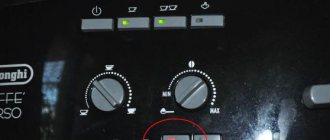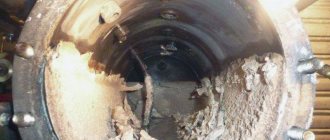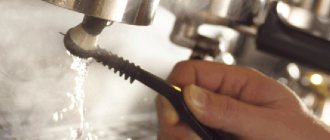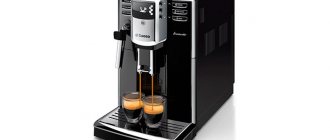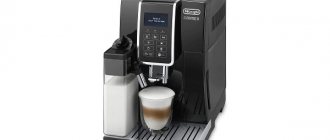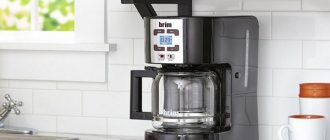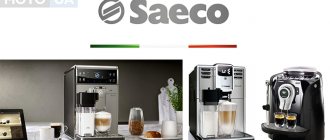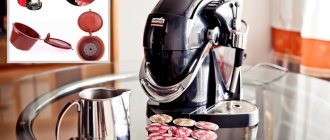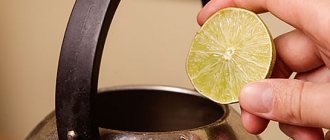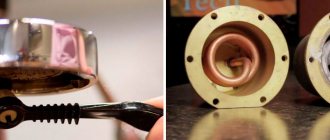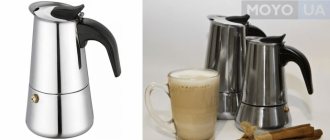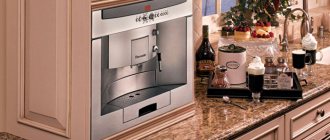Decalcifier for coffee machines DEMO CAFEDEM ACIDEM CM 5x20G. An acidic powder product is used to remove limescale from boilers and heating elements of coffee machines.
Suitable for coffee machines of the brands Saeco, Jura, Franke, Bosch, Delonghi, kaffit, Krups, Melitta, etc.
The unique formula of bound organic acids allows you to thoroughly and harmlessly decalcify the internal surface of the coffee machine, removing rust, scale, oxides, build-ups and other salt and mineral deposits.
Peculiarities:
- Working concentration: 50-100 g/liter of water at a temperature of +60-70°C
- After each wash, rinse the coffee machine thoroughly with clean water until all detergent residues are removed.
- Ingredients: Sulfamic acid (>25%), complexing agents, corrosion inhibitors
- Physico-chemical properties: white powder with a slight characteristic odor, pH (1%) = 1.0 – 3.0
- Store the product unopened at a temperature from -20 to +35°C
- 5 bags of 20 g
- Suitable for all types of coffee machines.
- Material restrictions: light and ferrous alloys must be processed only after additional testing
- Appearance: white powder. Smell: light characteristic
- pH of 1% solution in distilled water: 1-3
Why clean your coffee machine?
Coffee machine service specialists assure that without regular cleaning, the device will last no more than 7–8 months. After this you will have to contact the service center. And let’s not even talk about delicious coffee. The fact is that the operation of the device is characterized by the following processes:
- the heating elements of the coffee machine become covered with scale - salt deposits destroy plastic and metal parts, increase the amount of energy consumed and the duration of preparation of the drink, and the taste of the coffee significantly deteriorates;
- the hydraulic system becomes clogged with sediments of coffee oils - it becomes difficult for water to seep through, the load on the mechanism of the device increases, the oils oxidize over time, acquiring an unpleasant taste and smell, which become the highlight of every cup of coffee;
- the internal mechanism of the cappuccino maker becomes covered with a milky coating - this is an excellent environment for the growth of bacteria;
- The liquid accumulated in the pan begins to emit a musty odor, and mold may form.
Only in a clean coffee machine can you prepare a truly tasty and aromatic drink.
Precautionary measures:
- Causes skin burns and eye damage.
- When working with the product, use hand and eye/face protection.
- In case of contact with skin or eyes, rinse thoroughly with water.
- If necessary, consult a medical specialist.
By supplying detergents for coffee machines and dishwashers for the kitchen, restaurants, cafes, canteens and any public catering establishments, the online store “Restaurant Komplekt” creates all the conditions for the convenience of customers. By purchasing DEMO CAFEDEM D22 1kg descaling agent for removing scale from coffee machines, you get a quality product at the best price of 495 rubles. with the possibility of delivering equipment throughout Russia, including Moscow and the Moscow region, free consultation from our specialists.
Transport costs and customer waiting time are reduced to a minimum! You can pick up the goods by self-pickup from the company’s own warehouses or from the warehouse of a regional dealer without waiting for delivery from Moscow and paying for transportation.
Citric acid for cleaning a coffee machine
This method should be used for household coffee machines; it helps eliminate scale of any thickness. It is noteworthy that many branded coffee machine cleaning products contain citric acid, so you can use it without damaging your equipment. This method has a number of advantages:
- a natural cleanser that will not harm the body even if it gets into the drink;
- effectively removes old scale;
- citric acid is cheaper than branded products.
Important! Using recipes with citric acid is safe, cheap and effective, the main thing is to choose the right proportion.
How often should you clean your coffee machine?
Cleaning a coffee machine involves:
- descaling (decalcification);
- getting rid of coffee oils;
- cleaning the cappuccino maker and milk jug;
- care for other parts - the pulp compartment, millstones, tray.
It is important to clean each part of the device regularly and with a certain frequency.
How to understand when it's time to descale
When the time comes to decalcify, a corresponding message will appear on the device display or a special indicator will light up (see instructions). However, not a single coffee machine has sensors that would detect the amount of scale. The devices count the cooked portions and, upon reaching the milestone specified by the manufacturer, inform the owner about the need for cleaning. But the rate of scale formation directly depends on the hardness of the water: the more impurities it contains, the more actively salts are deposited on the heating elements. Therefore, before using the coffee machine, it is recommended to set the water hardness level. You can check this value using a special indicator strip that comes with the device.
Special test strips will help determine the hardness of water.
The process of programming hardness for a specific coffee machine model is carried out in accordance with the instructions. And now the number of servings after which the device will need to be cleaned is determined depending on the specified indicator.
It is recommended to descale immediately after the appliance informs you that it is necessary to do so.
Some coffee machines equipped with a built-in water purification filter may not indicate at all that the device needs cleaning. A priori, it is believed that the liquid being poured is crystal clear and no scale is formed. But even in this case, experts recommend decalcification at least once a year.
The following “symptoms” indicate that it’s time to descale:
- the stream of coffee entering the cup is thinner than usual;
- white sediment in the drink;
- strong noise during operation of the device;
- The taste of the coffee deteriorates and its temperature decreases.
Prevention of rapid scale formation is to use soft water purified with a household or special filter for a coffee machine. But the most effective option is the use of a reverse osmosis purification system. It includes a filter with a special membrane, the pores of which are comparable in size to water molecules, i.e. it is permeable only to particles whose diameter is equal to or less than the diameter of water molecules. The liquid passes through the membrane and is cleared of substances dissolved in it.
Frequency of getting rid of coffee oils
A pour-over type coffee machine is equipped with a brewing unit, which during operation becomes clogged with oils and particles of ground coffee. There are two types of infusers:
- Removable. It must be taken out and washed under running water once every 1–3 weeks. After preparing 200–500 cups of coffee, it is recommended to clean the device using special products.
- Fixed. It must be cleaned with special products immediately after the coffee machine gives the appropriate signal (see instructions).
Owners of espresso machines in which the horn acts as a brewing unit must daily:
- Wipe the steam wand after each use of the device;
- After each cup of espresso, wipe the dispersion screen with a damp soft cloth;
- Wash the filter and holder (portafilter) after preparing the drink.
You also need to back-clean the valve 1-2 times a year or more often using a blind filter - a special filter without holes that is used to clean the brew group.
Coffee beans are rich in essential oils, which accumulate and hinder the operation of the device.
Cleaning other parts
Cleaning parts that many users forget about should also be carried out with some regularity:
- water collection tray - drain accumulated liquid daily, rinse completely 1-2 times a month;
- compartment for collecting cake - clean immediately after the device gives the corresponding signal;
- grinders - clean every 3-4 kg of coffee;
- cappuccino maker - every day, the part with both the built-in jug and the outlet tube must be disassembled (how to do this is described in the instructions for the coffee machine) and washed.
Cleaning other parts
The body of the device should be regularly wiped with a soft damp cloth to remove dust and other contaminants. It is important to promptly drain the liquid accumulated in the pan to avoid the appearance of mold and musty smell. Also, 1-2 times a month you need to wash this part with running water or in a dishwasher at a temperature of no more than 60 °C. It can be reinstalled only after thorough drying.
Compartment for pulp
The pulp compartment must be removed while the machine is turned on. After emptying, rinse it with running water and wipe dry.
If you empty the hopper while the device is turned off, the coffee cycle counter will not reset and the message about the need to empty the container will not disappear from the screen.
Coffee grinder
Cleaning the millstone mechanism is carried out as follows:
- Empty the bean hopper of coffee.
- Activate the grinding mode to get rid of the remaining grains.
- Place the tablet or powder into the hopper.
- Turn on grinding for 5-6 seconds.
- Fill the compartment with grains.
- Prepare 2-3 cups of coffee, pouring the drink down the sink each time.
As a cleaning agent, powder made from food starch is used, which absorbs accumulated fats, or special tablets, for example, Puly grind.
In order for the coffee machine grinders to remain functional for a long time, they must be cleaned regularly.
Cleaning the milk jug and cappuccino maker
The automatic cappuccino maker is cleaned as follows:
- Instead of a container with milk, place a container with clean water.
- Activate milk supply.
- Drive 50 ml of water or more in this way until clear liquid begins to come out.
If this procedure is carried out regularly, you can do without chemicals.
Regular maintenance of the cappuccino maker is carried out without the use of special products.
If you use old milk or skip cleaning, you may need to use special products:
- Urnex Rinza “Liquid for washing milk systems”;
- WMF cleaner cream milk;
- Neodisher “Cappuccino Maker Detergent”;
- Topperr 3041 "Dairy system cleaner".
In this case, water with the product dissolved in it is driven through the device (see the dosage in the instructions for the specific product).
Video: how to clean the cappuccino maker
Cleaning the device from coffee oils
Removing coffee oils means cleaning the hydraulic system of the coffee machine. The method depends on the type of device.
Pour-type coffee machine
Operating procedure:
- Disconnect the removable brewing device and rinse with running water.
- Clean the strainer holes clogged with coffee residues using a soap solution, brush or needle.
- Install the element back after it has completely dried.
Cleaning using special means (both removable and non-removable brewing unit) is carried out in strict accordance with the instructions for the device. Typically, the algorithm is as follows:
- Place an oil remover tablet into the ground coffee chamber.
- Install the “Ground Coffee” program.
- Place a cup under the dispenser and activate the largest volume of espresso brewing.
- Drain the released water (as a rule, the liquid comes out white and with a foam similar to soap).
- Prepare coffee 2-3 times, but do not drink it, but pour it into the sink.
- After 30 minutes, repeat the procedure 2-3 times with clean water.
Special products are used to clean the brewing unit from coffee oils.
Products for cleaning coffee machines from oils
Cleaning from coffee oils is carried out using tablets with the appropriate markings: cleans, clean, cleaning, for cleansing coffee oils, etc. Judging by the reviews, they have proven themselves well:
- Topper 3037;
- JURA;
- Melitta 1500791;
- Bosch 311769;
- Cleancaf Urnex;
- Neohome;
- Filtero 613 and others.
The most affordable coffee oil tablets are produced by Melitta and Bosch. On average, one cleaning costs 250 rubles. It’s even cheaper to buy similar products from Topper 3037 (35–40 rubles per cleaning).
Melitta coffee oil tablets - a branded product at an affordable price
Video: cleaning the device from coffee oils (using Jura as an example)
Espresso machine
Carob-type coffee makers are cleaned of oils as follows:
- Pour cleaning powder into the blind filter or place a tablet in the holder.
- Install the portafilter into the brew group.
- Turn on the spill cycle for 10 seconds.
- Repeat the sequence (turn on the spill - turn off - wait) 5 times. After this, water should be discharged from the brewing group into the drip tray, which is accompanied by a characteristic sound of water being drained.
- Loosen the horn, but do not remove it from the brew group head.
- Turn on the water supply: the liquid will put pressure on the blind filter and will soon begin to overflow. At this point, you need to start tilting and rotating the horn for more effective cleaning.
- Take out the portafilter and start pouring water to wash the divider; rinse the holder itself with running water.
The horn (portafilter, holder) is washed with running water - Repeat steps 1–6 with clean water without a special product to clean the system of chemicals.
- Clean the threads of the group head and the edges of the dispersion screen using a toothbrush.
- Wash parts.
If necessary, the holder, filter and tube tip are cleaned by soaking in the solution:
- Dilute the cleaning powder in water (see dosage in the instructions for the specific product).
- Immerse the parts in a container with the solution for half an hour.
- Clean off dirt and rinse thoroughly in plenty of running water.
What tools to use
Typically, powders are used to remove oils in carob coffee machines, for example:
- JOEGLO "Espresso machine cleaner";
- ASCACO “Cleaning agent for removing coffee oils from elements of espresso coffee machines”;
- PULY POWDER Plus “Cleaning agent for espresso coffee machines”;
- Urnex Cafiza 2 “Cleaning agent for espresso machines.”
There are also products in tablet form, for example Cafiza E16 “Cleaner for espresso machines and super-automatic machines”.
To clean carob-type coffee machines from coffee oils, special products are produced in the form of powder or tablets.
How to clean the device?
So what is the best way to clean your coffee machine? The simplest and most effective, but very expensive option is special means. They are usually sold in hardware stores or in large stores, that is, where the appliances themselves are located. Such formulations are most often produced in the form of tablets, which is very convenient.
The advantages of using ready-made specialized formulations include effectiveness, the availability of detailed instructions, as well as safety for the device and ease of use. Simply open the package and place the tablet into the container.
If you want to save money, you can try using folk remedies:
- Lemon acid. Pour about three to four tablespoons of powder into the container and proceed with the usual cleaning described above.
- Instead of citric acid, use regular lemon juice. Squeeze it out of the fruit and strain through gauze folded several times so that particles of pulp do not get stuck in the device. For a liter of water you will need the juice of two medium lemons.
- You can use acetic acid, but not concentrated, preferably 9%. Add about a quarter cup of acid to a reservoir filled with water and begin the procedure.
- Soda will also help. Just pour hot water into the container and dissolve the soda in it so that not a single particle remains.
- Use alcohol. A liter of water will require half a glass.
